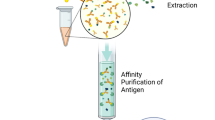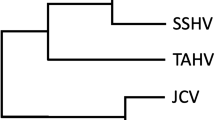Abstract
EXPERIMENTAL allergic encephalomyelitis (EAE) can be produced in guinea-pigs by injection of acid extracts of central nervous tissue mixed with Freund's complete adjuvant. Some authors claim that the active factor in these extracts is protein1–4 while others claim that it can be polypeptide5–9. From extracts of ox spinal cord we have isolated a bovine encephalitogenic polypeptide fraction (BEP) and also an encephalitogenic protein fraction. Similar fractions were also isolated from extracts of guinea-pig brain. As other encephalitogens may be isolated in the future from nervous tissue of various species it would be important to have a simple means of identifying and classifying them. At present it is difficult to correlate the results of chemical and immunological expariments from different laboratories because authors often fail to describe adequately the nature and homogeneity of their encephalitogenic preparations. This paper describes a simple gel electrophoresis procedure which can test the homogeneity of encephalitogenic preparations and provides a convenient classification of the proteins or polypeptides in such materials. The proposed classification is based on a comparison of the mobility of the encephalitogen relative to the mobility of cytcochrome c.
This is a preview of subscription content, access via your institution
Access options
Subscribe to this journal
Receive 51 print issues and online access
$199.00 per year
only $3.90 per issue
Buy this article
- Purchase on Springer Link
- Instant access to full article PDF
Prices may be subject to local taxes which are calculated during checkout
Similar content being viewed by others
References
Kies, M. W., Ann. N.Y. Acad. Sci., 122, 161 (1965).
Wolfgram, F., Ann. N.Y. Acad. Sci., 122, 104 (1965).
Caspary, E. A., and Field, E. J., Ann. N.Y. Acad. Sci., 122, 182 (1965).
Kibler, R. F., Fox, R. H., and Shapira, R., Nature, 204, 1273 (1964).
Robertson, D. M., Blight, R., and Lumsden, C. E., Nature, 196, 1005 (1962).
Lumsden, C. E., Robertson, D. M., and Blight, R., J. Neurochem., 113, 127 (1966).
Nakao, A., and Roboz-Einstein, E., Ann. N.Y. Acad. Sci., 122, 171 (1965).
Kongruth, S. E., and Anderson, J. W., J. Cell Biol., 26, 157 (1965).
Carnegie, P. R., and Lumsden, C. E., Nature, 209, 1354 (1966).
Driedger, A., Johnson, L. D., and Marko, A. M., Can. J. Biochem. Physiol., 41, 2507 (1963).
Schonne, E., Protides of the Biological Fluids, 11, 368 (1964).
Kies, M. W., Alvord, E. C., Martenson, R. E., and LeBaron, F. N., Science, 151, 821 (1966).
Kies, M. W., Proc. Fifth Intern. Cong. Neuropathology, Zurich, 1965, 257 (Excerpta Medica, Amsterdam, 1966).
Bagdasarian, M., Matheson, N. A., Synge, R. L. M., and Youngson, M. A., Biochem. J., 91, 91 (1964).
Author information
Authors and Affiliations
Rights and permissions
About this article
Cite this article
CARNEGIE, P., LAMOUREUX, G. & BENCINA, B. Proposed Technique for classifying and identifying Encephalitogens. Nature 214, 407–408 (1967). https://doi.org/10.1038/214407a0
Received:
Revised:
Issue Date:
DOI: https://doi.org/10.1038/214407a0
This article is cited by
-
The proteins of human myelin in inborn errors of metabolism and in chromosomal anomalies
Acta Neuropathologica (1973)
Comments
By submitting a comment you agree to abide by our Terms and Community Guidelines. If you find something abusive or that does not comply with our terms or guidelines please flag it as inappropriate.



